Choosing the Best Beading Thread for Your Jewelry Project
Find out how to choose the best beading thread for your jewelry project in our full guide. Your creations deserve the best and every bead deserves the right match!
When you are putting together the materials to make a beautiful necklace or bracelet, one of the main points that you will need to consider is the type of beading thread you use.
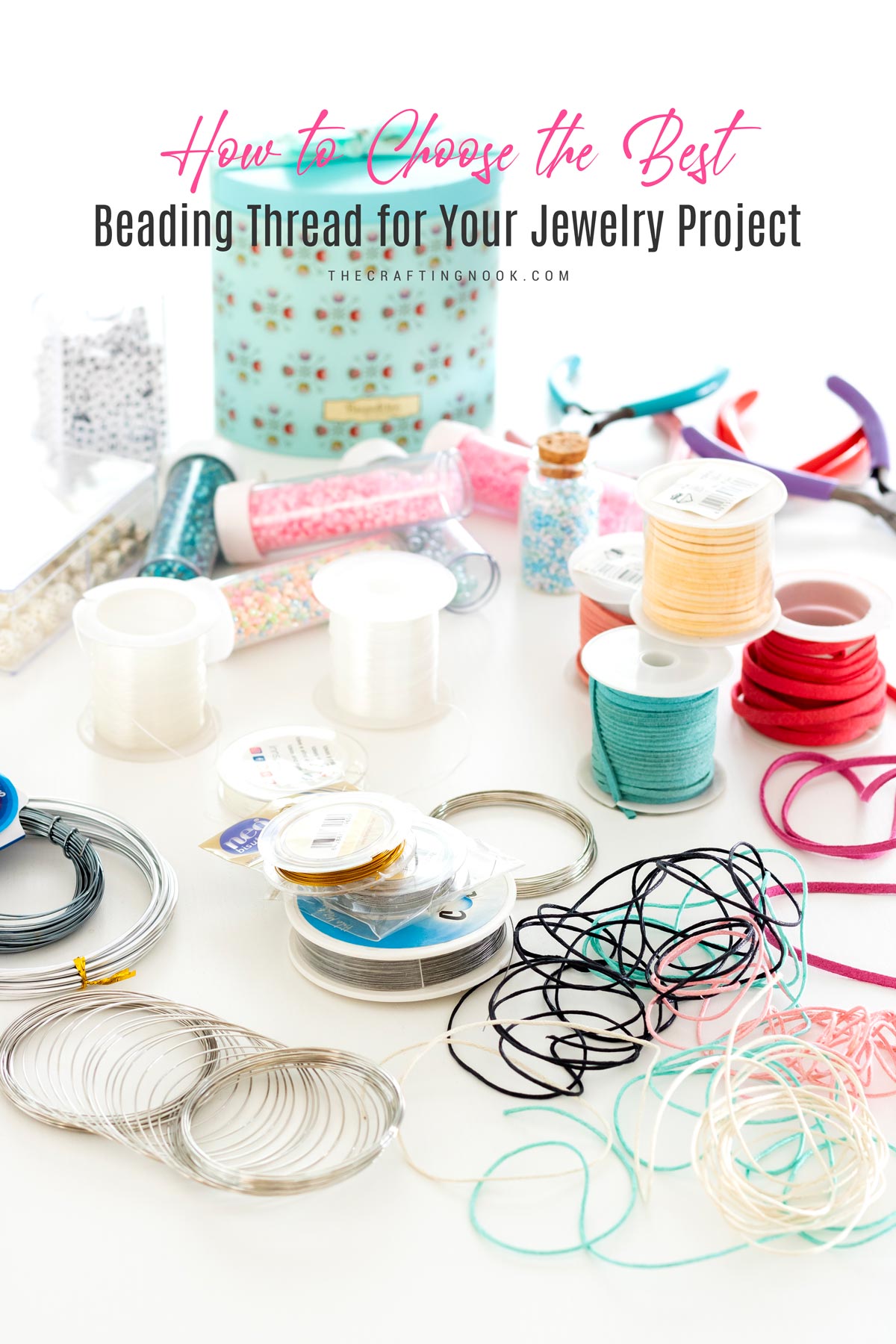
Table of Contents
Why Choosing the Right Beading Thread Matters
Many jewelers will get distracted by the beautiful beads and not pay much attention to the thread. However, choosing the right thread is important and it will affect the look, feel, and durability of the piece of jewelry itself.
This post may contain affiliate links. Please read our Disclosure Policy.
If you love doing DIY projects and crafting, you understand that paying attention to the small details is important when making beautiful jewelry.
When you are making jewelry like bracelets, necklaces, or earrings, the kind of thread you choose is very important for how the finished product will look. This impacts how strong, bendable, and good-looking your jewelry looks. Okay, let’s go through the choices you have:
How to Choose the Best Beading Thread for Your Jewelry Project
There are many different types of thread available for beading, so how can you choose the one that is best for your particular project? It might seem overwhelming at first, but after a while, you will start to get an understanding of the different types of threads and find a few different ones that cover all of your needs.
When you are making your decision, there are a lot of factors that you should consider when choosing the beading through for your jewelry project.
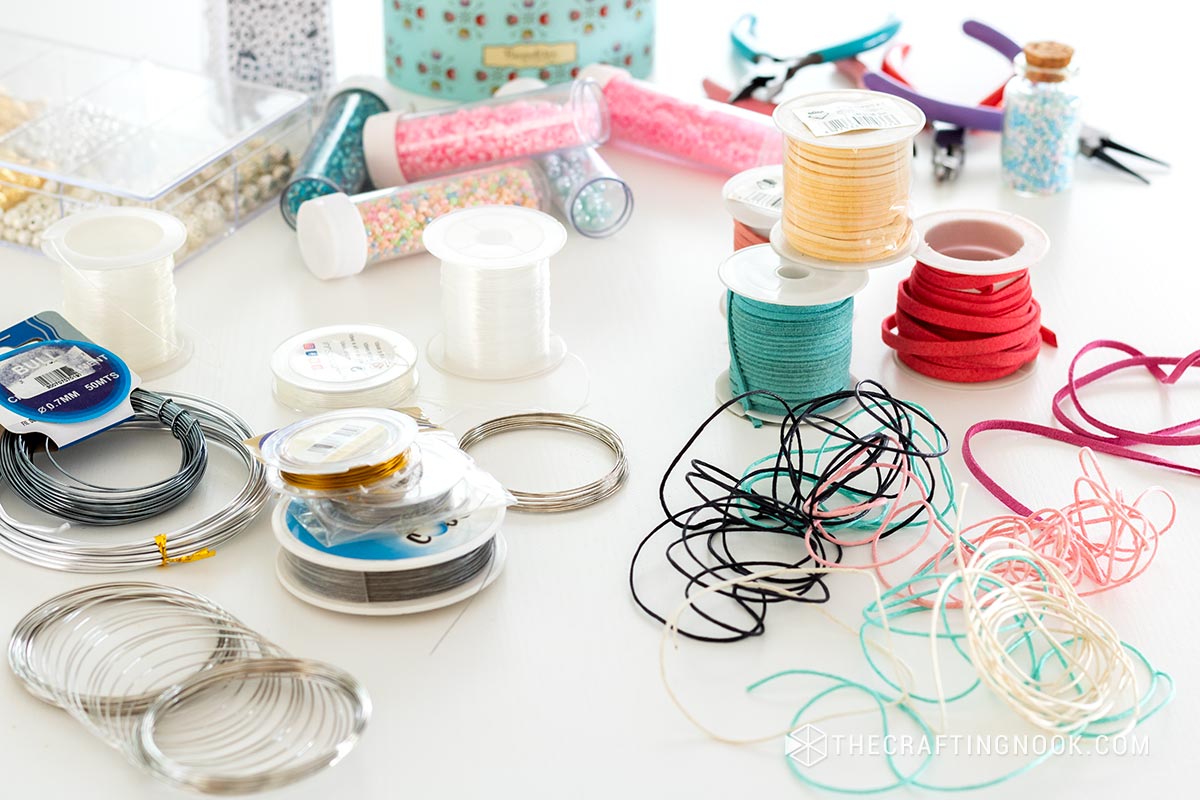
Each type of beading thread has its unique characteristics and best use cases. When selecting your thread, consider the nature of your jewelry project, the weight and size of your beads, and your desired style. May your jewelry creations always shine with the heart and soul you pour into them!
1. Wire: Unmatched Stability
For jewelry that needs structure and stability, wire is your best friend. It’s ideal for projects involving heavy beads or designs that need to hold a specific shape.
Stainless steel and copper wire are common choices. Keep in mind that wire can be a bit tricky to work with, so it’s essential to practice your techniques before diving into a major project.

Wire is the heavyweight champion when it comes to stability and structure in jewelry-making:
Consider the Strength and Fit
The strength and the fit of the beading wire that you choose will be determined by its diameter. For example, it makes more sense to use larger diameter wire for projects with big and heavy beads and a smaller diameter wire for lightweight beads. Also, you will need to use thinner wire so that it will be able to pass through the small bead holes.
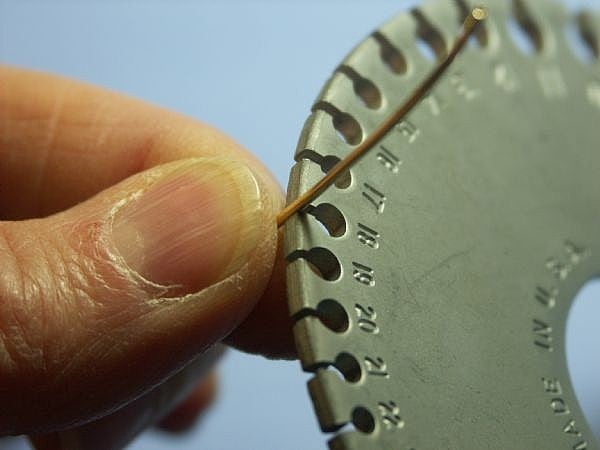
If you have a project with a lot of sharp-edged beads you will need to choose a thread or wire that will not be damaged by the beads themselves over time. Stainless steel metal wire is a good choice for this because it will withstand wear and tear and last for a very long time.
Durability
Wire, whether stainless steel or copper, provides unparalleled durability. It’s your choice for projects involving heavy or larger beads. It holds its shape well, ensuring your jewelry maintains its form.
Different Gauges
You’ll find wires in various gauges. The thicker the wire, the sturdier it is. Consider using thicker wire for projects that need extra support.
flexibility
Beading wire is labeled according to the number of strands that it contains, as this wire is like a cable. It is made up of many different steel strands that are woven together. The number of strands within the cable will have an effect on its flexibility.
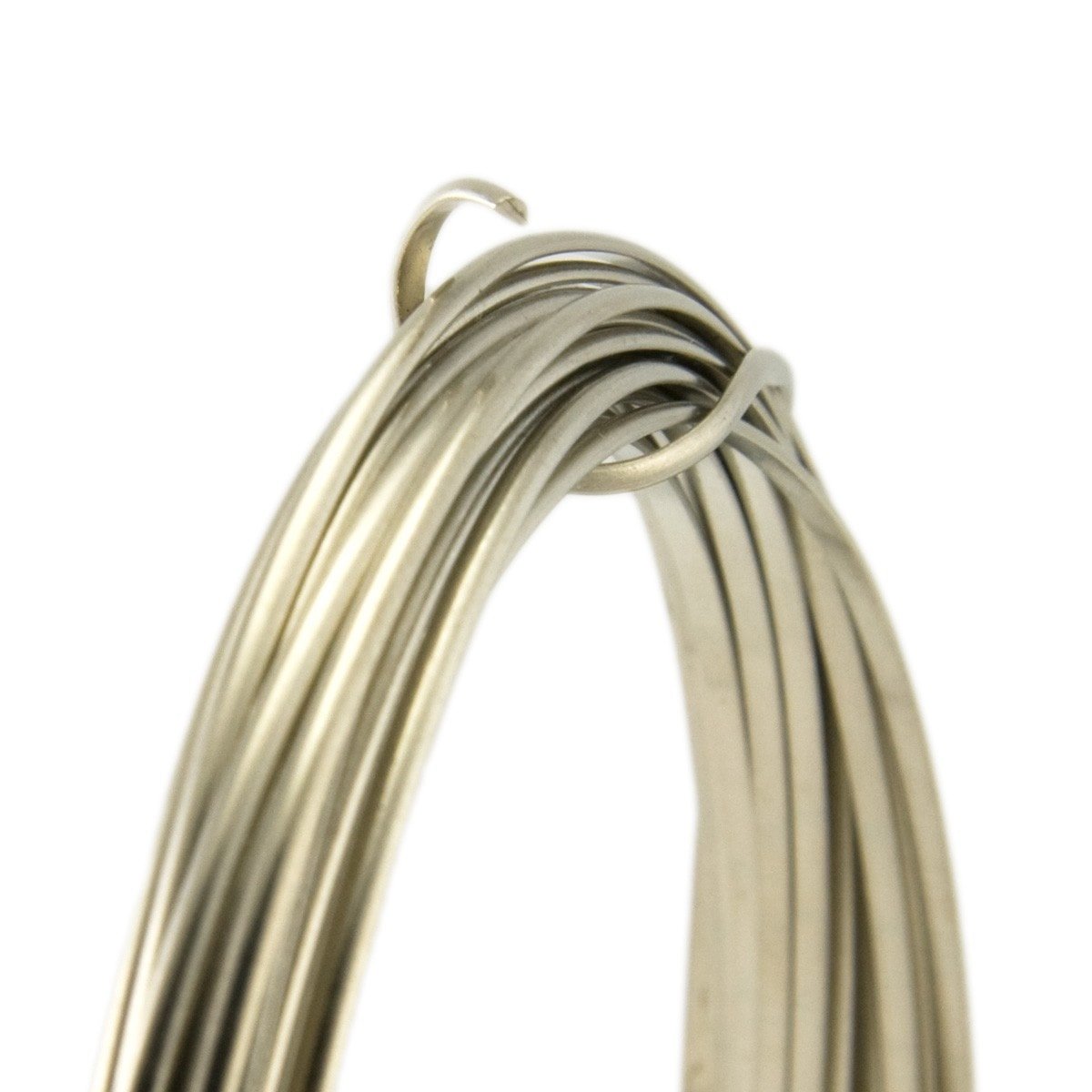
If a beading wire has a number of strands within it, it will be quite flexible and malleable. If it has only a few strands woven together it will feel stiffer and wire-like.
It’s up to you whether you want a flexible or stiffer feeling for your jewelry. Generally, more flexible wire costs more, but it will give your jewelry a much better quality feel. Also, the flexible wire will not be at risk of kinking or bending in a wrong angle. You need to determine whether you are making high-quality jewelry with more flexible wire because your price point will ultimately need to reflect that.
However, if you want to create a piece of jewelry that is very sculptural and holds its form, you will want to use a very stiff and inflexible piece of wire. This way, you can mold the wire into a shape and it will stay that way.
Diameter of the Bead Holes
Of course, no matter how nice a particular bead wire or thread is – it will not work if you cannot get it to fit through the holes of the beads!
Your wire needs to be at least a couple of millimeters smaller than the holes within your beads. You don’t want the beads to be just barely able to squeeze onto the thread, because then the piece of jewelry will feel inflexible and the beads will rub against the wire and damage it.

If you are not sure of the diameter of the beads, you can always take them to the shop with you and ask them if you can test them with the beading wire samples.
Color of the Wire
In some jewelry designs, the bead or the wire will be visible once the jewelry is completed. In this case, it should either be clear or have a color that complements the rest of the design. If you are using transparent beads, a colored thread can have a really interesting and attractive look.

These are just a few of the factors that you should consider when you choose the beading thread or wire for your next project. The wire that you choose will have an impact on your design, so think about it wisely. When you have found a great type of wire at the right price, you might even want to consider buying it in bulk so that you can use it in many different projects!
Wire Techniques
Working with wire involves different techniques like wire wrapping, coiling, and bending. It’s important to familiarize yourself with these techniques for successful wire-based jewelry.
Examples:
Wire-Wrapped Gemstone Pendants: Create stunning wire-wrapped gemstone pendants that showcase the natural beauty of the stones. Wire’s durability ensures your designs are robust and secure.
Sculptural Jewelry: If you’re crafting sculptural jewelry, like wire bangles or intricate wire earrings, wire allows you to maintain the shape and structure of your pieces.
2. Nylon Thread: The Versatile Workhorse
Nylon threads are like the trusty sidekick in the world of jewelry making. They come in various thicknesses, from ultra-fine to thicker varieties, making them suitable for a wide range of projects. They’re flexible and durable, making them perfect for beads of different sizes and weights.
If you’re creating delicate, intricate jewelry pieces, consider using a thin nylon thread. For heavier, statement pieces, opt for a thicker gauge.
Size Matters
Thinner nylon threads, like Nymo or Silamide, are ideal for delicate beadwork such as weaving intricate patterns or stitching seed beads. On the other hand, thicker threads, like C-Lon or S-Lon, are excellent for projects involving larger, heavier beads. They offer strength and stability, which is crucial for necklaces, bracelets, or anklets.
Knots and Clasps:
Nylon threads are easy to knot, which is great for securing your jewelry and adding clasps. They provide a secure hold, ensuring your creations withstand everyday wear.
Color Choices:
Nylon threads come in a vast array of colors, allowing you to find the perfect match for your beads. This versatility lets you blend your thread seamlessly with your design, making it almost invisible.
Examples:
Delicate Seed Bead Bracelets: Thin nylon threads, like Nymo or Silamide, are perfect for intricate patterns with small seed beads. You can create beautiful, delicate bracelets with ease.
Statement Necklace with Heavy Beads: Opt for thicker nylon threads, such as C-Lon or S-Lon, when you’re designing a bold statement necklace with larger, heavier beads. The strength and stability of nylon ensure your necklace stands the test of time.
3. Silk Thread: Timeless Elegance
Silk threads exude sophistication and are often the go-to choice for creating classic and elegant jewelry. They are available in various colors, allowing you to match them perfectly with your beads.
Silk threads are soft and supple, making them ideal for stringing pearls and other delicate beads. However, they are less durable than nylon, so they may not be the best choice for heavy or everyday-wear jewelry.

Silk threads are all about timeless beauty and grace, perfect for creating classic and elegant jewelry:
Softness and Flexibility:
Silk threads are incredibly soft and flexible, making them ideal for stringing pearls and delicate beads. They drape beautifully, enhancing the overall aesthetics of your jewelry.
Finer Gauges:
They are available in finer gauges, which are well-suited for delicate projects. If you’re crafting a pearl necklace or intricate beadwork, silk is your best friend.
Versatile Colors:
Silk threads are available in a variety of colors. They offer a slightly different look than nylon threads, giving your jewelry a touch of elegance.
Example:
Pearl Necklace: Silk thread is the go-to choice for stringing pearls. Its softness and flexibility enhance the lustrous beauty of pearls, creating a timeless and elegant pearl necklace.
Intricate Beadwork: If you’re working on intricate beadwork projects, like a delicate beadwoven bracelet with small glass beads, silk thread is ideal. It drapes gracefully, giving your jewelry a refined finish.
4. Elastic Cord: Quick and Convenient
Elastic cord is perfect for those trendy, stretchy bracelets that are so popular right now. It’s easy to use, making it a fantastic choice for beginners. However, it may not be the best option for heavy or bulky beads, as it can stretch out over time.
Elastic cord is all about ease and flexibility:
Stretchy and Snug:
An elastic cord is excellent for creating stretchy bracelets. It provides a snug fit and is incredibly comfortable to wear.
Bead Size Consideration:
For small to medium-sized beads, an elastic cord is a great choice. Keep in mind that very heavy or large beads can stretch out the cord over time.
Knot-Free Design:
With an elastic cord, you don’t need to fuss with knots and clasps. Simply stretch it to slide your jewelry on and off.
Examples:
Stretchy Beaded Bracelets: For quick and comfortable stretchy beaded bracelets, use an elastic cord. It’s perfect for projects where you want an effortless fit without the need for clasps.
Kids’ Jewelry: Elastic cord is great for crafting jewelry with kids. They can easily slide their creations on and off, making it a fun and fuss-free option.
5. Fishing Line: Strength and Transparency
A monofilament fishing line is another option to consider. It’s incredibly strong and virtually invisible, making it an excellent choice for intricate, floating designs. Just be careful when using it with heavier beads, as it can be prone to stretching.
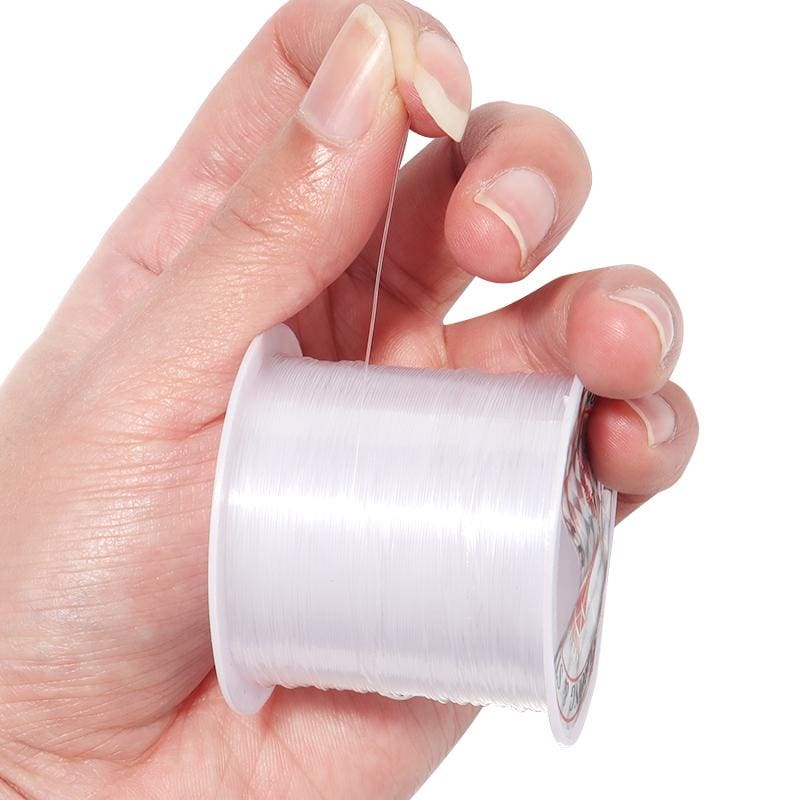
Monofilament fishing line offers a unique blend of strength and transparency:
Invisibility:
This type of line is virtually invisible when used in jewelry. It’s great for projects where you want your beads to appear as if they’re floating on your skin.
Strength and Resilience:
The monofilament line is strong and resistant to fraying. It’s perfect for intricate, delicate designs.
Bead Size Matters:
It’s crucial to choose the right weight of the fishing line based on the bead size. Smaller beads can be strung on lighter lines, while heavier beads require a stronger line.
Examples:
Floating Bead Necklaces: Create necklaces with a “floating bead” effect, where the beads appear to hover on your skin. The transparency of the fishing line enhances this illusion beautifully.
Invisible Bracelets: If you want your bracelets to have an almost invisible, floating look, a monofilament line is the way to go. It’s strong and nearly disappears against your skin.
6. Leather Cord: Rustic Charm
If you’re going for a rustic or bohemian look, a leather cord is a fantastic choice. It adds a natural touch to your jewelry pieces and works well with wooden or stone beads. Keep in mind that leather may not be the best option for very delicate projects.
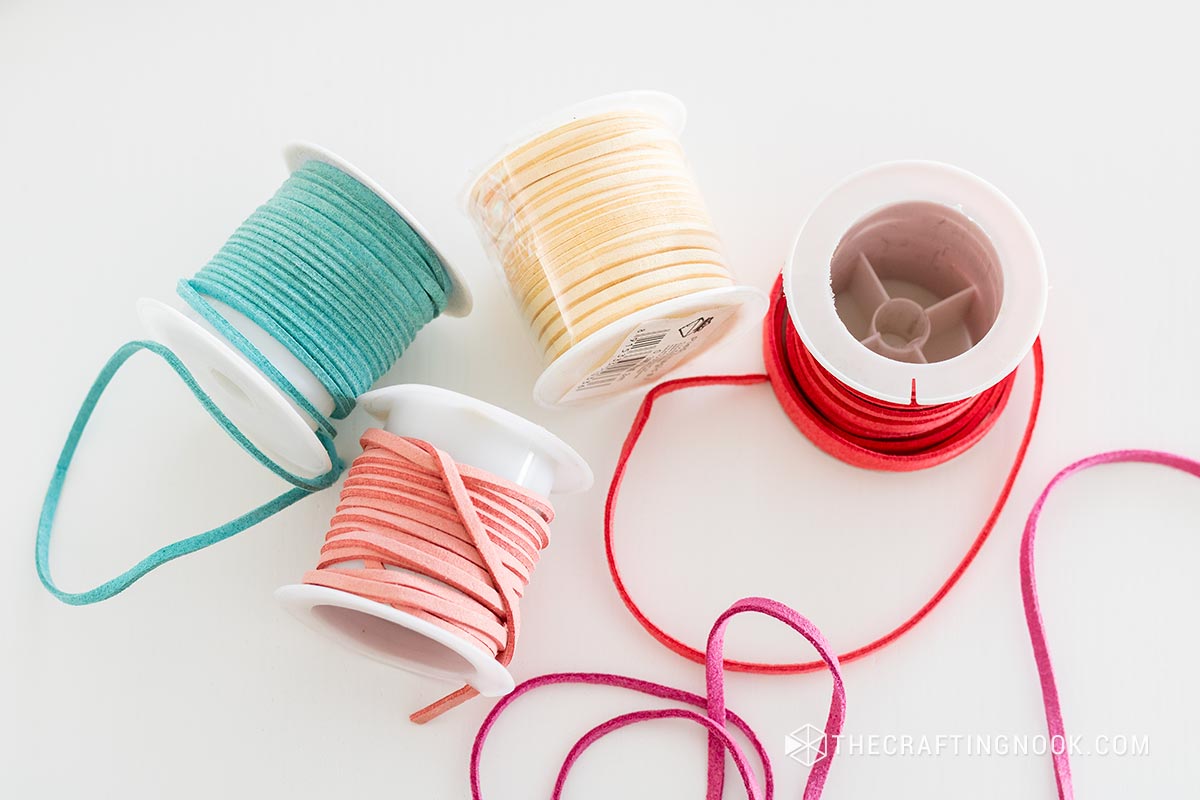
Leather cord adds a touch of natural, rustic charm to your jewelry:
Organic Look:
Leather gives your jewelry a rugged and natural appeal, making it ideal for bohemian or casual designs.
Compatible Beads:
It pairs wonderfully with wooden, stone, or ceramic beads. The contrast between the rough texture of leather and the earthy tones of these beads can result in striking jewelry pieces.
Knotting or Clasps:
You can secure leather cords using knots for a more rustic look or add clasps for a neater finish, depending on your design preference.

Examples:
Braided Wrap Bracelets: Craft modern-style wrap bracelets using leather cord. The combination of leather with shiny metals exudes a modern, nature-inspired charm.
Men’s Jewelry: Leather cord is often used in men’s jewelry designs, such as leather necklaces or bracelets, giving them a rugged and masculine appeal.
7. FireLine and WildFire: Specialized for Beaders
Beading threads like FireLine and WildFire are specifically designed for beadwork. They’re ultra-strong and resistant to fraying. They come in various thicknesses, so you can choose the one that suits your project best.
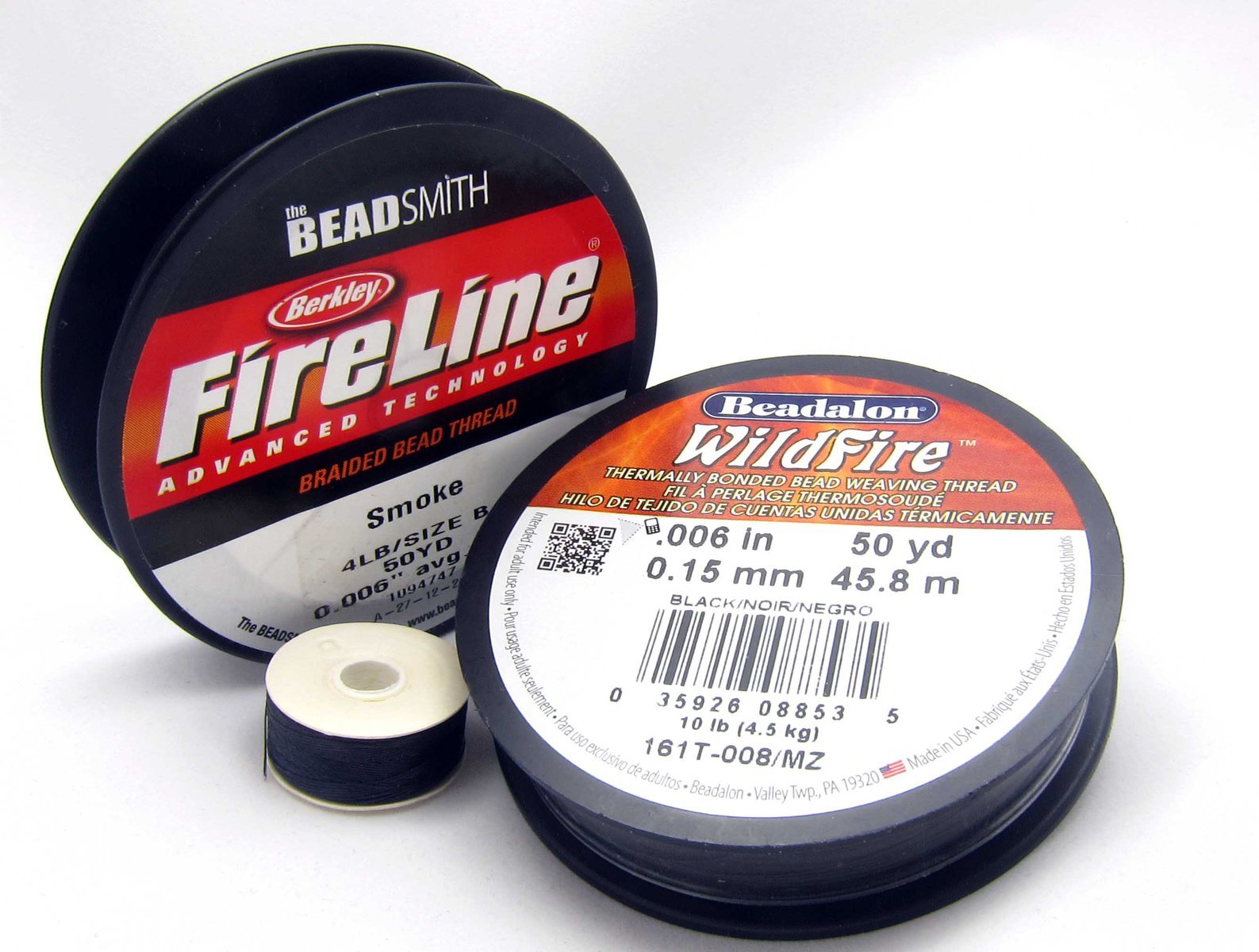
Beading threads like FireLine and WildFire cater specifically to the needs of beaders:
Ultra-Strength:
These threads are renowned for their strength and resistance to fraying, making them excellent for intricate beadwork and projects that require longevity.
Various Thicknesses:
Beading threads come in different thicknesses, allowing you to choose the one that complements your project best.
Bead Weaving:
If you’re into intricate bead weaving patterns or intricate stitches, beading threads are your trusted companions.
Examples:
Intricate Bead Weaving: When you’re creating intricate bead weaving patterns, such as peyote stitch or herringbone, beading threads are your best friends. They offer the strength and fine gauge needed for these delicate designs.
Seed Bead Earrings: Beading threads are perfect for crafting seed bead earrings with intricate patterns. They ensure your earrings are both beautiful and durable.
8. Memory Wire: The Coiled Marvel
Memory wire is a distinctive material known for its coiled shape and spring-like characteristics. Here’s what you need to know about using memory wire in your jewelry projects:
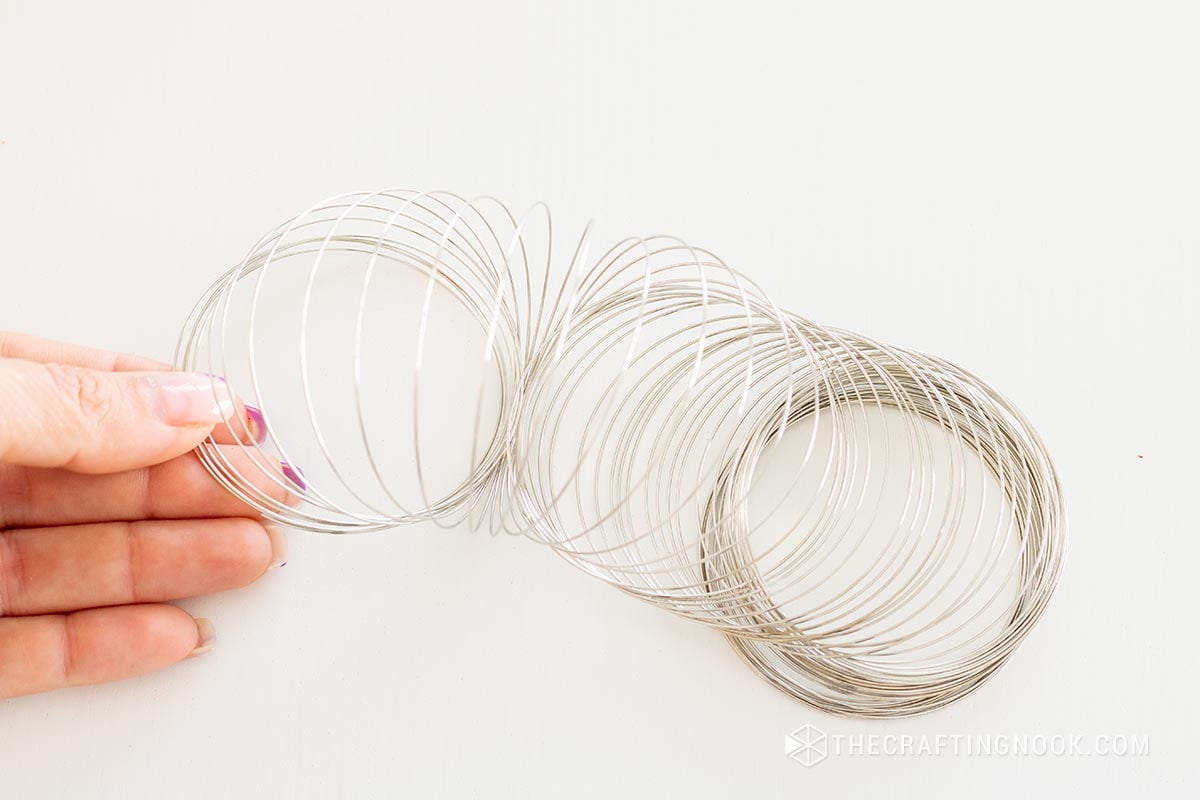
Inherent Shape:
Memory wire holds its coiled shape, making it perfect for creating bracelets, chokers, and rings. It requires no clasps, as it loops around the wrist or neck.
Ease of Use
It’s incredibly easy to work with because you can simply string beads directly onto the wire. No need for knots or findings.
Strength and Durability:
Memory wire is robust and retains its shape, ensuring your jewelry remains secure and maintains its form.
Customizable
While memory wire comes in predefined coil sizes, you can easily cut and reshape it to fit your desired jewelry length.
Bead Choice
Consider using larger, heavier beads as memory wire can support the weight of these beads without stretching.
Design Possibilities
Memory wire is often used for creating striking, multiple-loop bracelets or statement chokers. It’s perfect for bold and eye-catching designs.
Finishing
To complete a memory wire jewelry piece, you can use specialized memory wire end caps or simply create a loop at the ends with pliers. This loop keeps your beads secure and prevents them from sliding off.
Examples:
Stackable Coil Bracelets: These bracelets wrap around your wrist multiple times, creating a trendy and layered look. You can mix and match different colors and bead types to craft unique combinations that suit your style.
Chokers: its inherent coiled shape allows for a snug fit around the neck without the need for a clasp. Chokers made with memory wire can be adorned with various beads, pendants, or charms to suit your design preferences.
Beading Tips
Always start by clearly defining your jewelry project. Is it a delicate bracelet with small seed beads or a chunky necklace with larger gemstones? The nature of your project will guide your thread choice.
If you’re making everyday-wear jewelry, like a bracelet, opt for a thread with high durability, such as nylon or a specialized beading thread.
When you’re going for elegance, silk thread may be ideal. If you prefer a rustic look, leather cord could be the perfect choice.
If you’re crafting stretch bracelets, choose an elastic cord that stretches comfortably without losing its elasticity over time.
Ensure that the thread can easily pass through the holes of your beads. This is especially important for seed beads, which often have very small holes.
Sometimes, the best way to choose the right thread is to test a few options with sample beads. This allows you to see how they perform in your specific project before committing to a full jewelry piece.
To sum up, when picking out the proper thread for beading, think about what kind of jewelry you are making, how heavy and big your beads are, and the style you want.
Don’t forget, that there’s no one-size-fits-all solution, but with this guide, you have the information you need to make a smart choice for your next DIY jewelry project. I hope you have fun making things, and I hope your creations shine with your love and passion.
Frequently Asked Questions
For heavy or large beads, consider using nylon thread. Its strength and durability make it suitable for supporting the weight of such beads. Select a thicker gauge for added stability.
While the monofilament fishing line is versatile, it’s not ideal for all bead types. It works best with beads that have smooth holes, as rough-edged holes can cause fraying. Consider its compatibility with your specific beads.
Nylon and polyester threads are quite similar. They both offer durability and strength. However, nylon tends to be more flexible, making it a better choice for intricate beadwork, while polyester has slightly less stretch and is often preferred for heavy or large beads.
While wire is typically used for structural and heavy designs, it’s possible to use fine-gauge wire for delicate jewelry. However, it may require extra care in shaping and securing the wire to maintain a delicate look.
Fun Handmade Jewelry Projects to Try
If you like this Beading Thread Choosing guide, you might also love these handmade jewelry projects too:
Some really cool handmade jewelry pieces from my favorite bloggers:
- Leather Wrap Bracelets with Charm by Amy Latta Creations.
- DIY Studded braid bracelets by A Pumpkin and a Princes.
- T-shirt yarn bracelets by Blue Bear Wood.
Share and PIN ME!!!
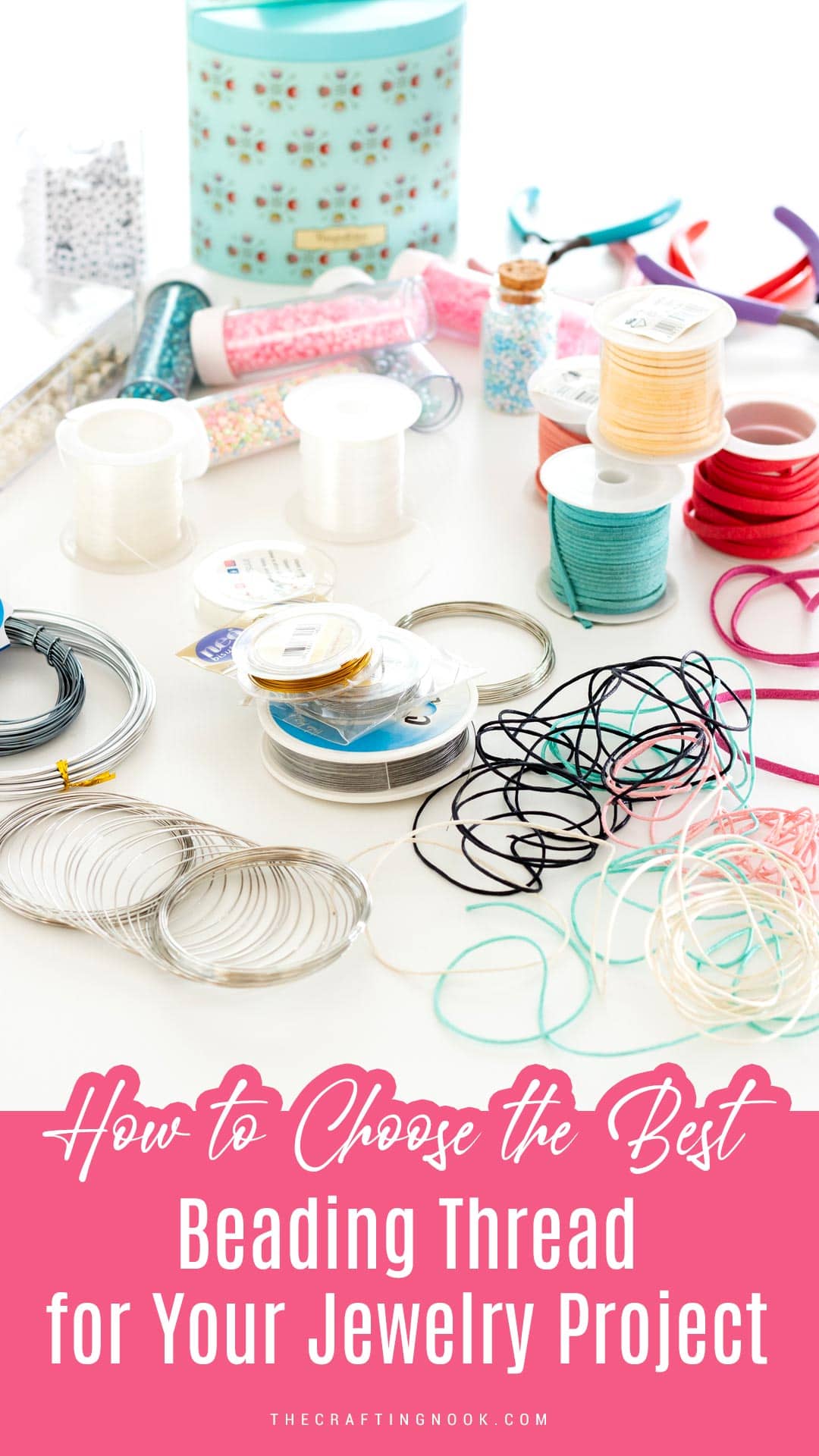
Til’ next time…


FREE WORKBOOK
Keeping your Sweet Home Organized
Learn how to create intentional habits and simple routines to Keep Your Home Organized. Plus freebies, printables, exclusive content, and tips.
Disclaimer: By clicking on the “Yes” button above you are giving me your consent to collect and use your information according to the law and My Policy Privacy. Zero Spam I promise!


